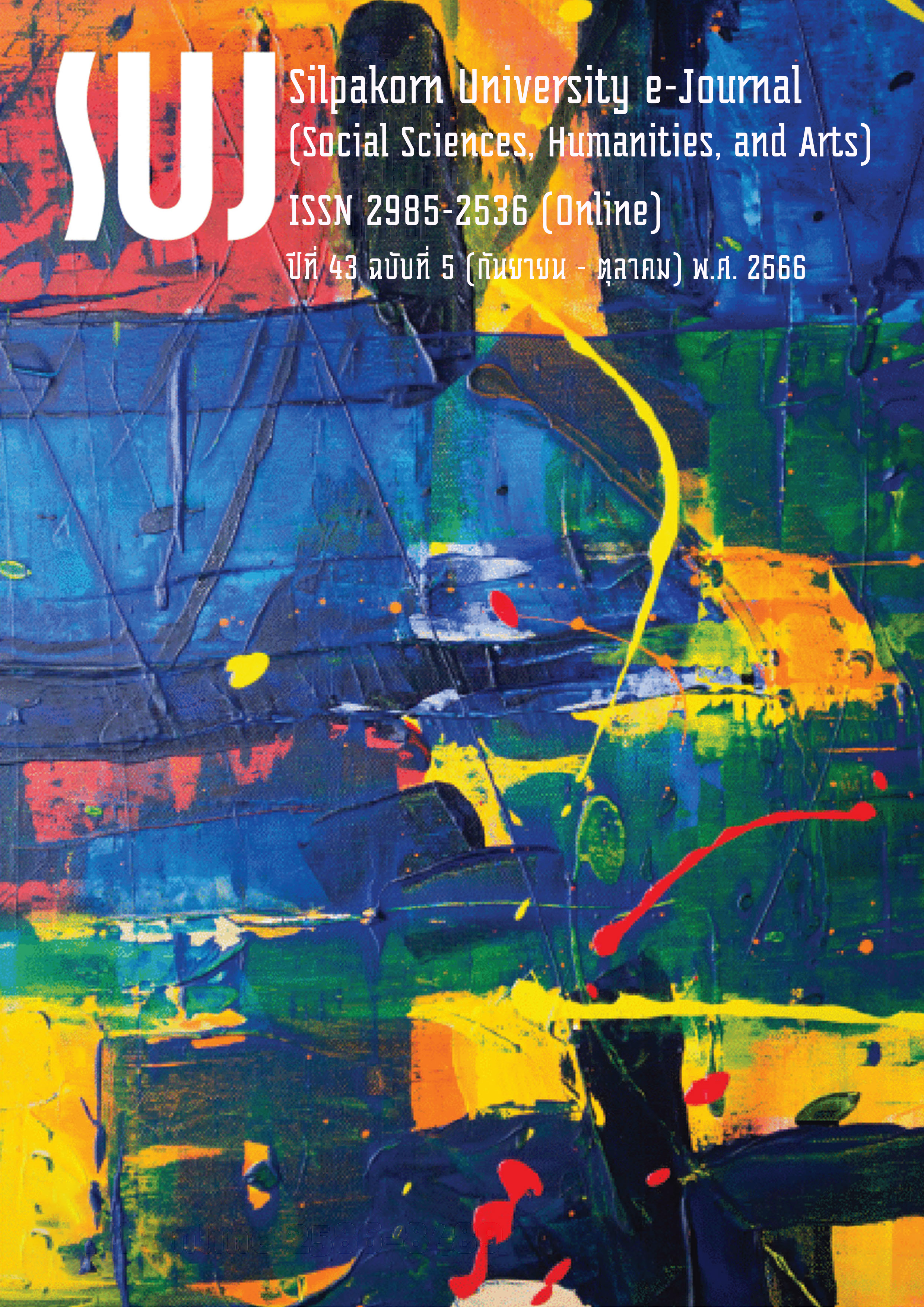มโนทัศน์ยูโทเปียและดิสโทเปีย: ทวิลักษณ์ของธรรมชาติและสิ่งแวดล้อมในวรรณคดีไทย (The concepts of Utopia and Dystopia: The duality of nature and environment in Thai literature)
Main Article Content
Abstract
บทความนี้มีวัตถุประสงค์เพื่อวิเคราะห์มโนทัศน์ยูโทเปียและดิสโทเปียในวรรณคดีไทยกับมิติทางธรรมชาติและสิ่งแวดล้อม การศึกษาครั้งนี้เป็นการวิจัยเชิงคุณภาพ โดยใช้วิธีวิจัยเอกสารจากตัวบทวรรณคดีไทย จำนวน 5 เรื่อง ผลการศึกษาพบ 2 ประเด็น คือ ประเด็นแรก มโนทัศน์ยูโทเปียในวรรณคดีไทยกับมิติธรรมชาติและสิ่งแวดล้อม พบความสัมพันธ์ระหว่างมโนทัศน์ยูโทเปียกับธรรมชาติและสิ่งแวดล้อมในลักษณะสุนทรียะเชิงนิเวศ แสดงถึงความสัมพันธ์ระหว่างธรรมชาติกับอารมณ์ของปัจเจกบุคคล และสภาวะสมบูรณ์แบบของธรรมชาติและสิ่งแวดล้อมในลักษณะอีโคโทเปีย ประเด็นที่สอง มโนทัศน์ดิสโทเปียในวรรณคดีไทยกับธรรมชาติและสิ่งแวดล้อม ซึ่งพบการควบคุมธรรมชาติและสิ่งแวดล้อมโดยมนุษย์ แสดงให้เห็นว่ามนุษย์มีอำนาจในการใช้ทรัพยากรธรรมชาติและสิ่งแวดล้อม และประเด็นธรรมชาติและสิ่งแวดล้อมมีอำนาจเหนือมนุษย์ คือพลังอำนาจควบคุมและลงโทษมนุษย์ให้อยู่ในศีลธรรม ดังนั้น มโนทัศน์ยูโทเปียและดิสโทเปียจึงมีลักษณะของทวิลักษณ์หรือคู่ตรงข้ามทางธรรมชาติและสิ่งแวดล้อมซึ่งปรากฏในวรรณคดีไทย ซึ่งได้แก่ ธรรมชาติและสิ่งแวดล้อมมีอำนาจเหนือมนุษย์ และมนุษย์มีอำนาจเหนือธรรมชาติและสิ่งแวดล้อม
The purpose of this article is to analyze the concepts of Utopia and Dystopia as portrayed through nature and environment in Thai literature. It is a qualitative study involving documentary research. The scope of the study encompasses five Thai literary works. The results of the study reveal two main points. Firstly, regarding the concept of Utopia represented through nature and environment in Thai literature, there exists a relationship between the concepts of Utopia and nature and environment in a utopian ecological sense. This demonstrates the connection between nature and an individual’s emotional state, as well as the harmonious state of nature and environment in an ecotopian sense. Secondly, the concept of Dystopia in Thai literature in relation to nature and the environment portrays human control over nature and the environment. This highlights human power in utilizing natural resources and the environment, and the theme of nature and the environment holding power over humans, enforcing moral order. Therefore, the concepts of Utopia and Dystopia, as represented through nature and the environment in Thai literature, are interconnected through the form of duality or binary opposition. On the one hand, nature and the environment possess power over human beings. On the other hand, human beings exert power over nature and the environment.
Article Details

This work is licensed under a Creative Commons Attribution-NonCommercial-NoDerivatives 4.0 International License.
References
Archer-Lean, C. (2009). Revisiting literary Utopias and Dystopias: Some new genres. Social Alternatives, 28(3): 3-7.
Bagchi, B. (2015). Utopian and Dystopian Literature: A Review Article of New Work by Fokkema; Prakash; Gordin, Tilley, Prakash; and Meisig. [Online]. Retrieved January 19, 2022 from https://docs.lib.purdue.edu/cgi/viewcontent.cgi?article=2743&context=clcweb
Buasomboon, Busaba. (1993). A Comparative Study of Three Utopian Novels: A Modern Utopia, Muang Nimitr and Walden Two (การศึกษาเปรียบเทียบนวนิยายแนวคิดสังคมอุดมคติในเรื่อง อะ โมเดิร์น ยูโทเปีย เรื่อง เมืองนิมิตร และเรื่องวอลเด็น ทู). Master’s dissertation, Chulalongkorn University, Bangkok, Thailand.
Chalayonnavin, Auschala. (2016). Utopia: It’s dimensions in social science (ยูโทเปีย: มิติทางสังคมศาสตร์). Journal of Public Administration and Politics, 5(2): 1-28.
Charoensin-o-larn, Chairat. (1999). Development Discourses: Power, Knowledge, Truth, Identity and Otherness (วาทกรรมการพัฒนา : อำนาจ ความรู้ ความจริง เอกลักษณ์ และความเป็นอื่น). Bangkok: Vibhasa.
Chitchamnong, Duangmon. (1997). Values and Outstanding Characteristics of Thai Literature in the Early Rattanakosin Period (คุณค่าและลักษณะเด่นของวรรณคดีไทย สมัยรัตนโกสินทร์ตอนต้น). Bangkok: Thammasat University Press.
Chronicle, Volume 37 (Part 63: Krung Gao (continued)) (ประชุมพงศาวดาร เล่ม 37 (ภาคที่ 63 : กรุงเก่า (ต่อ))). (1969). Bangkok: Kurusapa Printing Ladphrao.
Department of Religious Affairs, Ministry of Education. (1982). Tipitaka Official Edition (พระไตรปิฎกภาษาไทย ฉบับหลวง) (4th ed.). Bangkok: Religious Affairs Press.
Phraya Lithai. (2011). Tribhumikata: The Story of the Three Planea of Existence (ไตรภูมิพระร่วง). Bangkok: Sinlapabannakhan.
Prachatai. (2015). Suradech Chotiudompan: Origins and Influences U-Dystopia Literature (สุรเดช โชติอุดมพันธ์: ต้นกำเนิดและอิทธิพล วรรณกรรม ยู, ดิส-โทเปีย). [Online]. Retrieved July 2, 2019 from https://prachatai.com/journal/2015/07/60233
Pradittatsanee, Darin. (2017). Ecocriticism: Introduction (การวิจารณ์วรรณกรรมแนวนิเวศ (Ecocriticism): บทแนะนำเบื้องต้น). In R. Satchaphan (Ed.), Theory and Art Criticism: Perspectives of Thai Academics (ทฤษฎีกับการวิจารณ์ศิลปะ: ทัศนะของนักวิชาการไทย), (pp. 236-327). Pathum Thani: Nakorn Publishing.
Royal Society. (2000). Dictionary of Philosophical Terms: English-Thai, The Royal Society Edition (พจนานุกรมศัพท์ปรัชญา อังกฤษ-ไทย ฉบับราชบัณฑิตยสถาน) (3rd ed.). Bangkok: The Royal Institute of Thailand.
Rukrien, Patraporn. (2016). Eco-Dystopia and Eco-Utopia in Kim Stanley Robinson’s Science Fiction (อีโค-ดิสโทเปียและอีโค-ยูโทเปียในบันเทิงคดีแนววิทยาศาสตร์ของคิม สแตนลีย์ โรบินสัน). Doctoral dissertation, Chulalongkorn University, Bangkok, Thailand.
Sangkhaphanthanon, Thanya. (2013). Ecocriticism in Thai Literature (วรรณคดีสีเขียว : กระบวนทัศน์และวาทกรรมธรรมชาติในวรรณคดีไทย). Pathum Thani: Nakorn Publishing.
Sangkhaphanthanon, Thanya. (2016). Contemporary Literary Theory (แว่นวรรณคดี ทฤษฎีร่วมสมัย). Pathum Thani: Nakorn Publishing.
Sunthorn Phu. (2000). Phra Chai Suriya (กาพย์เรื่องพระไชยสุริยา) (9th ed.). Bangkok: Tarnpanya.
The Fine Arts Department. (1986). Literature in the Ayutthaya Period Volume 1 (วรรณกรรมสมัยอยุธยา เล่ม 1). Bangkok: Office of Literature and History, The Fine Arts Department.
The Fine Arts Department. (2002). Literature in the Ayutthaya Period Volume 3 (วรรณกรรมสมัยอยุธยา เล่ม 3) (2nd ed.). Bangkok: Office of Literature and History, The Fine Arts Department.

